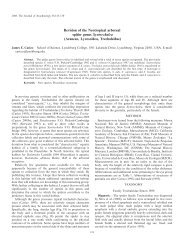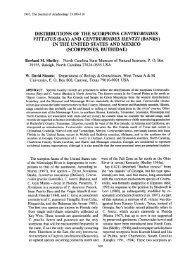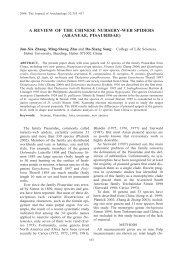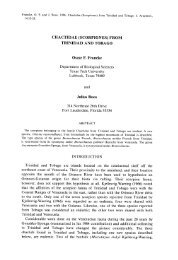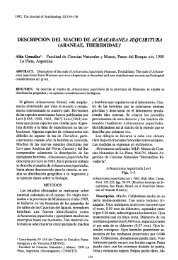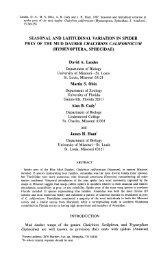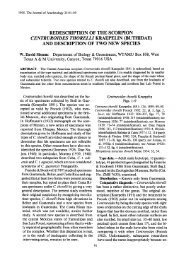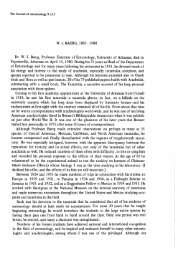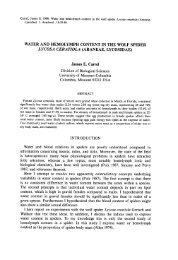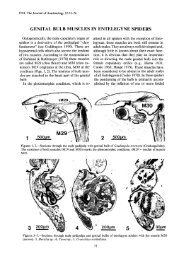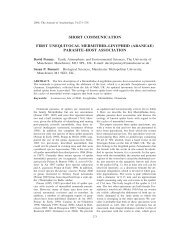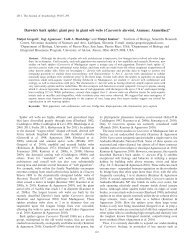monoamines in the brain of tarantulas - American Arachnological ...
monoamines in the brain of tarantulas - American Arachnological ...
monoamines in the brain of tarantulas - American Arachnological ...
Create successful ePaper yourself
Turn your PDF publications into a flip-book with our unique Google optimized e-Paper software.
2001. The Journal <strong>of</strong> Arachnology 29:388–395<br />
MONOAMINES IN THE BRAIN OF TARANTULAS<br />
(APHONOPELMA HENTZI) (ARANEAE, THERAPHOSIDAE):<br />
DIFFERENCES ASSOCIATED WITH MALE<br />
AGONISTIC INTERACTIONS<br />
Fred Punzo: Dept. <strong>of</strong> Biology, Box 5F, University <strong>of</strong> Tampa, 401 W. Kennedy Blvd.,<br />
Tampa, Florida 33606 USA<br />
Thomas Punzo: 2782 Johnson Dr., Albuquerque, New Mexico 50052 USA<br />
ABSTRACT. Experiments were conducted to determ<strong>in</strong>e <strong>the</strong> effects <strong>of</strong> male-male agonistic encounters<br />
on changes <strong>in</strong> monoam<strong>in</strong>e neurotransmitter concentrations <strong>in</strong> <strong>the</strong> supraesophageal ganglion (bra<strong>in</strong>) <strong>of</strong> <strong>the</strong><br />
tarantula, Aphonopelma hentzi. Seroton<strong>in</strong> levels were significantly reduced 30 m<strong>in</strong> after fight<strong>in</strong>g <strong>in</strong> both<br />
dom<strong>in</strong>ant (66.5 � 9.1 SE nmol/mg prote<strong>in</strong>) and subord<strong>in</strong>ate (42.8 � 7.6) animals as compared to isolated<br />
controls (89.7 � 13.2), and <strong>the</strong>se differences persisted for up to 24 h. A similar decrease was found for<br />
octopam<strong>in</strong>e concentrations <strong>in</strong> dom<strong>in</strong>ant (43.7 � 7.7) and subord<strong>in</strong>ate (31.2 � 4.9) spiders when compared<br />
to controls (56.9 � 5.8). In addition, seroton<strong>in</strong> and octopam<strong>in</strong>e levels were significantly lower <strong>in</strong> subord<strong>in</strong>ate<br />
vs. dom<strong>in</strong>ant spiders. Agonistic <strong>in</strong>teractions had no effect on <strong>the</strong> concentrations <strong>of</strong> dopam<strong>in</strong>e,<br />
norep<strong>in</strong>ephr<strong>in</strong>e, and ep<strong>in</strong>ephr<strong>in</strong>e. In isolated control spiders, seroton<strong>in</strong> (89.7 � 13.2 SE nmol/mg prote<strong>in</strong>)<br />
was present <strong>in</strong> highest concentration <strong>in</strong> <strong>the</strong> bra<strong>in</strong>, followed by octopam<strong>in</strong>e (56.9 � 5.8 nmol/mg), dopam<strong>in</strong>e<br />
(22.4 � 3.8 pmol/mg), norep<strong>in</strong>ephr<strong>in</strong>e (15.3 � 4.7 pmol/mg), and ep<strong>in</strong>ephr<strong>in</strong>e (0.57 � 0.2 pmol/mg). The<br />
results <strong>in</strong>dicate that follow<strong>in</strong>g agonistic encounters, monoam<strong>in</strong>e concentrations <strong>in</strong> <strong>the</strong> bra<strong>in</strong> decrease to<br />
different levels <strong>in</strong> w<strong>in</strong>ners and losers. This is <strong>the</strong> first demonstration that <strong>the</strong> establishment <strong>of</strong> social status<br />
causes changes <strong>in</strong> bra<strong>in</strong> <strong>monoam<strong>in</strong>es</strong> <strong>in</strong> spiders.<br />
Keywords: Agonistic <strong>in</strong>teractions, Aphonopelma, CNS <strong>monoam<strong>in</strong>es</strong>, males<br />
Activation <strong>of</strong> monoam<strong>in</strong>ergic systems <strong>in</strong><br />
<strong>the</strong> central nervous system (CNS) has been<br />
implicated <strong>in</strong> <strong>the</strong> mediation <strong>of</strong> short-term and<br />
chronic physiological stress responses as well<br />
as aggressive and social dom<strong>in</strong>ance relationships<br />
<strong>in</strong> numerous taxa (Eichelman 1987;<br />
Bicker & Menzel 1989; Haney et al. 1990;<br />
Summers et al. 1995). Most <strong>of</strong> this work has<br />
focused on social <strong>in</strong>teractions <strong>in</strong> vertebrates<br />
exposed to staged encounters between conspecifics<br />
under laboratory conditions. For example,<br />
<strong>the</strong> social status <strong>of</strong> subord<strong>in</strong>ate animals<br />
is associated with an <strong>in</strong>crease <strong>in</strong> <strong>the</strong> utilization<br />
<strong>of</strong> <strong>the</strong> <strong>in</strong>dolalkylam<strong>in</strong>e neurotransmitter (NT)<br />
seroton<strong>in</strong> (5-HT, 5-hydroxytryptam<strong>in</strong>e) <strong>in</strong> various<br />
bra<strong>in</strong> regions from fish to mammals (Haney<br />
et al. 1990; W<strong>in</strong>berg et al. 1997; Punzo<br />
2000a). In addition, activation <strong>of</strong> bra<strong>in</strong> catecholam<strong>in</strong>ergic<br />
systems <strong>in</strong>clud<strong>in</strong>g dopam<strong>in</strong>e<br />
(DA), norep<strong>in</strong>ephr<strong>in</strong>e (NE), and ep<strong>in</strong>ephr<strong>in</strong>e<br />
(Epi) <strong>in</strong> vertebrates is associated with <strong>in</strong>creased<br />
levels <strong>of</strong> aggression and dom<strong>in</strong>ance<br />
(Eichelman 1987; Matter et al. 1998).<br />
In general, <strong>the</strong> bra<strong>in</strong> or supraesophageal<br />
388<br />
ganglion (SEG) <strong>of</strong> arthropods lies above <strong>the</strong><br />
esophagus and consists <strong>of</strong> three major bra<strong>in</strong><br />
regions: <strong>the</strong> protocerebrum, which conta<strong>in</strong>s<br />
<strong>the</strong> ‘higher bra<strong>in</strong> centers’ <strong>in</strong>clud<strong>in</strong>g <strong>the</strong> optic<br />
lobes and nerves; <strong>the</strong> central body, corpora<br />
pedunculata and a variable number <strong>of</strong> ganglia<br />
and associated neuropils; <strong>the</strong> deuterocerebrum,<br />
which <strong>in</strong>nervates <strong>the</strong> antennae (reduced<br />
<strong>in</strong> arachnids); and <strong>the</strong> tritocerebrum, which <strong>in</strong>nervates<br />
<strong>the</strong> mouthparts (Horridge 1965; Gupta<br />
1987). In spiders, <strong>the</strong> CNS is highly condensed<br />
anteriorly, and <strong>the</strong> SEG consists<br />
primarily <strong>of</strong> <strong>the</strong> cheliceral and optic nerves,<br />
optic neuropils (masses <strong>of</strong> axonal fiber tracts)<br />
for primary and secondary eyes (‘corpora pedunculata’),<br />
and a loosely organized central<br />
body (Babu 1985; Wegerh<strong>of</strong>f & Breidbach<br />
1995).There have been few studies on neurochemical<br />
parameters associated with behavior<br />
<strong>in</strong> general, and agonistic <strong>in</strong>teractions specifically,<br />
<strong>in</strong> arthropods and o<strong>the</strong>r <strong>in</strong>vertebrates.<br />
For example, <strong>in</strong>creases <strong>in</strong> protocerebral RNA<br />
and prote<strong>in</strong> syn<strong>the</strong>sis have been shown to accompany<br />
learn<strong>in</strong>g <strong>in</strong> molluscs (Kerkut et al.
PUNZO & PUNZO—TARANTULA BRAIN MONOAMINES<br />
1970; Adamo & Chase 1991), decapod crustaceans<br />
(Punzo 1985), <strong>in</strong>sects (L<strong>in</strong> & Roel<strong>of</strong>s<br />
1992; Punzo 1996), and spiders (Punzo<br />
1988a). Cycloheximide-<strong>in</strong>duced <strong>in</strong>hibition <strong>of</strong><br />
bra<strong>in</strong> prote<strong>in</strong> syn<strong>the</strong>sis impaired learn<strong>in</strong>g and<br />
memory <strong>in</strong> <strong>in</strong>sects (Jaffe 1980) and spiders<br />
(Punzo 1988a), as well as <strong>in</strong>nate phototactic<br />
behavior <strong>in</strong> tenebrionid and passalid beetles<br />
(Punzo & Jellies 1980). Changes <strong>in</strong> levels <strong>of</strong><br />
bra<strong>in</strong> <strong>monoam<strong>in</strong>es</strong> have been implicated <strong>in</strong> a<br />
variety <strong>of</strong> ontogenetic shifts <strong>in</strong> behavior <strong>in</strong><br />
honeybee workers <strong>in</strong>clud<strong>in</strong>g <strong>the</strong> onset <strong>of</strong> nestguard<strong>in</strong>g<br />
behavior (Moore et al. 1987) and<br />
discrim<strong>in</strong>ation between olfactory cues (Macmillan<br />
& Mercer 1987).<br />
With respect to aggression and agonistic <strong>in</strong>teractions,<br />
octopam<strong>in</strong>e turnover rates <strong>in</strong>creased<br />
significantly <strong>in</strong> crickets after fight<strong>in</strong>g<br />
with conspecifics (Adamo et al. 1995). Increased<br />
forag<strong>in</strong>g activities and nest defense<br />
were correlated with higher concentrations <strong>of</strong><br />
octopam<strong>in</strong>e (OA), dopam<strong>in</strong>e (DA), and seroton<strong>in</strong><br />
(5-HT) <strong>in</strong> <strong>the</strong> SEG <strong>of</strong> worker honeybees<br />
(Harris & Woodr<strong>in</strong>g 1992). Indeed, it has been<br />
suggested that OA is part <strong>of</strong> a general arousal<br />
system which prepares <strong>in</strong>sects for a variety <strong>of</strong><br />
vigorous skeletal-muscular activities, territorial<br />
defense, and helps <strong>the</strong> animal deal with<br />
stressful conditions (Corbet 1991; Orchard et<br />
al. 1993). Increased 5-HT levels <strong>in</strong> <strong>the</strong> bra<strong>in</strong><br />
(SEG) have been implicated <strong>in</strong> <strong>the</strong> onset <strong>of</strong><br />
flight behavior <strong>in</strong> weevils (Guerra et al. 1991).<br />
Lobsters exhibit<strong>in</strong>g dom<strong>in</strong>ance over conspecifics<br />
exhibited higher levels <strong>of</strong> CNS 5-HT<br />
when compared with subord<strong>in</strong>ate animals<br />
(Kravitz 1988).<br />
Changes <strong>in</strong> SEG am<strong>in</strong>e concentrations as<br />
well as o<strong>the</strong>r NTs were shown to be associated<br />
with ontogenetic shifts <strong>in</strong> behavior <strong>in</strong> solifugids<br />
(Punzo 1993, 1994). First nymphal <strong>in</strong>stars<br />
(N1) typically have poorly developed chelicerae,<br />
and are gregarious, do not hunt prey, and<br />
rema<strong>in</strong> <strong>in</strong> <strong>the</strong> nest with <strong>the</strong>ir sibl<strong>in</strong>gs and maternal<br />
parent. However, after molt<strong>in</strong>g, second<strong>in</strong>star<br />
nymphs (N2) possess functional chelicerae<br />
and become aggressive (Punzo 1998a).<br />
They will cannabilize one ano<strong>the</strong>r if <strong>the</strong>y do<br />
not disperse from <strong>the</strong> nest. This pronounced<br />
<strong>in</strong>crease <strong>in</strong> aggression is associated with significant<br />
changes <strong>in</strong> bra<strong>in</strong> 5-HT and DA levels,<br />
although OA levels rema<strong>in</strong>ed relatively constant<br />
throughout postembryonic development<br />
(Punzo 1994). In addition, later nymphal <strong>in</strong>stars<br />
(N5—N8) exhibited higher bra<strong>in</strong> concen-<br />
389<br />
trations <strong>of</strong> acetylchol<strong>in</strong>e (ACh), norep<strong>in</strong>ephr<strong>in</strong>e<br />
(NE), and acetylchol<strong>in</strong>esterase (AChE) as<br />
compared to younger <strong>in</strong>stars (Punzo 1993).<br />
Theraphosid spiders exhibit a variety <strong>of</strong> aggressive<br />
behaviors. Some <strong>of</strong> <strong>the</strong>se <strong>in</strong>volve<br />
male-male agonistic <strong>in</strong>teractions (Baerg 1958;<br />
M<strong>in</strong>ch 1977; Punzo & Henderson 1999; Punzo<br />
2000b), while o<strong>the</strong>rs <strong>in</strong>volve males and females,<br />
especially dur<strong>in</strong>g courtship and mat<strong>in</strong>g<br />
(Costa & Perez-Miles 1992; Shill<strong>in</strong>gton &<br />
Verrell 1997), and sometimes end <strong>in</strong> sexual<br />
cannibalism (Punzo & Henderson 1999). A<br />
previous study showed that agonistic <strong>in</strong>teractions<br />
between paired conspecific males <strong>of</strong><br />
Aphonopelma hentzi (Girard 1854) were observed<br />
<strong>in</strong> 24 out <strong>of</strong> 27 (88.9%) staged encounters<br />
<strong>in</strong> <strong>the</strong> laboratory (Punzo & Henderson<br />
1999). These encounters were <strong>in</strong>itiated by<br />
vigorous leg-fenc<strong>in</strong>g with each protagonist<br />
push<strong>in</strong>g forcefully aga<strong>in</strong>st its opponent. These<br />
fenc<strong>in</strong>g bouts were <strong>in</strong>terrupted from time to<br />
time with at least one <strong>of</strong> <strong>the</strong> males exhibit<strong>in</strong>g<br />
a threat display (elevation <strong>of</strong> <strong>the</strong> anterior end<br />
<strong>of</strong> <strong>the</strong> body, first pair <strong>of</strong> legs and pedipalps,<br />
and open<strong>in</strong>g <strong>of</strong> <strong>the</strong> fangs). At least one male<br />
exhibited a strike response toward his opponent<br />
<strong>in</strong> 11 out <strong>of</strong> 24 cases (45.8%). In eight<br />
<strong>of</strong> <strong>the</strong>se <strong>in</strong>stances (33.3%), one <strong>of</strong> <strong>the</strong> males<br />
was killed.<br />
The purpose <strong>of</strong> this study was to <strong>in</strong>vestigate<br />
neurochemical parameters associated with agonistic<br />
<strong>in</strong>teractions between males <strong>of</strong> <strong>the</strong> <strong>the</strong>raphosid<br />
spider, Aphonopelma hentzi. Neurotransmitters<br />
and comodulators are important<br />
regulatory molecules required for <strong>the</strong> transmission<br />
<strong>of</strong> <strong>in</strong>formation (nerve impulses) along<br />
neural pathways <strong>in</strong>volved <strong>in</strong> <strong>the</strong> control <strong>of</strong><br />
motor movements as well as ‘mood’ and motivational<br />
states (Ansell & Bradley 1973).<br />
Specifically, we were <strong>in</strong>terested <strong>in</strong> whe<strong>the</strong>r or<br />
not <strong>the</strong>re were any differences <strong>in</strong> <strong>the</strong> concentrations<br />
<strong>of</strong> <strong>monoam<strong>in</strong>es</strong> (OA, DA, NE, Epi,<br />
5-HT) <strong>in</strong> <strong>the</strong> bra<strong>in</strong>s (SEG) <strong>of</strong> dom<strong>in</strong>ant (‘w<strong>in</strong>ners’)<br />
vs. subord<strong>in</strong>ate (‘losers’) males follow<strong>in</strong>g<br />
agonistic encounters. To our knowledge,<br />
this is <strong>the</strong> first study to address neurochemical<br />
correlates <strong>of</strong> aggression <strong>in</strong> spiders.<br />
METHODS<br />
Animals.—Males were collected dur<strong>in</strong>g<br />
July and August <strong>of</strong> 1997 at a site 3.5 km S <strong>of</strong><br />
Elg<strong>in</strong>, Texas (30�32�N, 97�29�W; Bastrop<br />
County). This site consisted <strong>of</strong> a dry wash and<br />
surround<strong>in</strong>g flood pla<strong>in</strong> consist<strong>in</strong>g <strong>of</strong> sand,
390 THE JOURNAL OF ARACHNOLOGY<br />
gravel and adobe soils, with numerous rocks,<br />
rock crevices, and burrows. The dom<strong>in</strong>ant<br />
vegetation <strong>in</strong>cluded prickly pear cactus<br />
(Opuntia), catclaw (Mimosa), mesquite (Prosopis),<br />
broom weed (Xauthocephalum), and<br />
mesquite grass (Bouteloua). Adult males rang<strong>in</strong>g<br />
<strong>in</strong> size from 4.2–6.7 g were abundant dur<strong>in</strong>g<br />
this period and were easily found mov<strong>in</strong>g<br />
about <strong>the</strong> surface between 2000–0300 h (Central<br />
Standard Time). Spiders were collected<br />
and weighed to <strong>the</strong> nearest 0.1 g us<strong>in</strong>g a<br />
Ohaus Model 87 portable electronic balance.<br />
Spiders were transported to <strong>the</strong> laboratory<br />
and housed <strong>in</strong>dividually <strong>in</strong> plastic cages (20<br />
� 16 � 8 cm). They were provided with water<br />
ad libitum and fed three times per week to<br />
satiation on a mixed diet <strong>of</strong> crickets (Gryllus<br />
sp.), mealworms (Tenebrio molitor), and<br />
grasshoppers (Schistocerca sp.). They were<br />
ma<strong>in</strong>ta<strong>in</strong>ed at 22 �C � 1�, 65% RH, and a<br />
photoperid regime <strong>of</strong> 12L:12D <strong>in</strong> a Percival<br />
Model 805 environmental chamber (Boone,<br />
Iowa). Adult males were kept <strong>in</strong> <strong>the</strong>se conditions<br />
for two weeks and <strong>the</strong>n re-weighed on<br />
<strong>the</strong> day before <strong>the</strong> <strong>in</strong>itiation <strong>of</strong> encounter trials.<br />
S<strong>in</strong>ce previous studies on arachnids have<br />
<strong>in</strong>dicated that differences <strong>in</strong> body size can <strong>in</strong>fluence<br />
<strong>the</strong> outcome <strong>of</strong> aggressive encounters<br />
(Faber & Bayliss 1993; Punzo 1998c, 2000b),<br />
only males <strong>of</strong> approximately similar size (6.2–<br />
6.7 g) were used for encounter trials and subsequent<br />
neurochemical analyses. Voucher<br />
specimens have been deposited <strong>in</strong> <strong>the</strong> Invertebrate<br />
Collection at <strong>the</strong> University <strong>of</strong> Tampa.<br />
Encounter trials.—We used a rectil<strong>in</strong>ear<br />
glass arena (26 � 16 � 12 cm) divided <strong>in</strong>to<br />
halves by an opaque divider to stage conspecific<br />
male encounters as described by Punzo<br />
(1998c). To summarize, <strong>the</strong> floor <strong>of</strong> <strong>the</strong> arena<br />
was provided with a layer <strong>of</strong> loose sand to a<br />
depth <strong>of</strong> 2 cm. All observations were conducted<br />
under Black light<strong>in</strong>g (BioQuip Onc.,<br />
Model 2804, Gardena, California). We used a<br />
Panasonic PS 150 tape recorder to record verbal<br />
descriptions <strong>of</strong> each encounter.<br />
Before each encounter trial, a male spider<br />
(chosen at random) was placed at each end <strong>of</strong><br />
<strong>the</strong> arena, separated by <strong>the</strong> opaque divider. A<br />
trial was <strong>in</strong>itiated by remov<strong>in</strong>g <strong>the</strong> divider and<br />
allow<strong>in</strong>g <strong>the</strong> animals to <strong>in</strong>teract. With<strong>in</strong> a period<br />
<strong>of</strong> time rang<strong>in</strong>g from 0.5–8.5 m<strong>in</strong> over<br />
all trials, <strong>the</strong> contestants made contact with<br />
one ano<strong>the</strong>r (usually with a front leg). In a few<br />
trials, one <strong>of</strong> <strong>the</strong> spiders would immediately<br />
attempt to flee after mak<strong>in</strong>g <strong>in</strong>itial contact<br />
with its opponent. These trials were not used<br />
<strong>in</strong> data analysis. In all o<strong>the</strong>r cases (n � 60<br />
trials), follow<strong>in</strong>g <strong>in</strong>itial contact, one <strong>of</strong> <strong>the</strong> spiders<br />
would beg<strong>in</strong> to push with its front pair<br />
<strong>of</strong> legs aga<strong>in</strong>st its opponent. The o<strong>the</strong>r spider<br />
rapidly responded <strong>in</strong> a similar fashion (legfenc<strong>in</strong>g).<br />
In o<strong>the</strong>r cases, after <strong>in</strong>itial contact,<br />
one or both spiders would exhibit <strong>the</strong> threat<br />
display, followed by ano<strong>the</strong>r bout <strong>of</strong> leg-fenc<strong>in</strong>g.<br />
In a few <strong>in</strong>stances <strong>the</strong> fight<strong>in</strong>g escalated<br />
until one or both spiders attempted to bite <strong>the</strong><br />
o<strong>the</strong>r. An encounter trial was term<strong>in</strong>ated if at<br />
any time dur<strong>in</strong>g <strong>the</strong> encounter one <strong>of</strong> <strong>the</strong> spiders<br />
backed away and rapidly fled from <strong>the</strong><br />
vic<strong>in</strong>ity <strong>of</strong> <strong>the</strong> o<strong>the</strong>r spider and attempted to<br />
crawl out <strong>of</strong> <strong>the</strong> chamber. The spider that held<br />
its ground was recorded as <strong>the</strong> ‘w<strong>in</strong>ner’ (dom<strong>in</strong>ant<br />
animal), and <strong>the</strong> spider that fled, <strong>the</strong><br />
‘loser’ (subord<strong>in</strong>ate). Each pair <strong>of</strong> contestants<br />
were subjected to only one encounter trial as<br />
described by Summers & Greenberg (1995) <strong>in</strong><br />
<strong>the</strong>ir study <strong>of</strong> male-male aggression <strong>in</strong> lizards.<br />
We conducted a total <strong>of</strong> 60 encounter trials<br />
compris<strong>in</strong>g 60 pairs <strong>of</strong> contestants (n � 120).<br />
Neurochemical analyses <strong>of</strong> bra<strong>in</strong> tissues.—Immediately<br />
follow<strong>in</strong>g <strong>the</strong>ir designation<br />
as dom<strong>in</strong>ant or subord<strong>in</strong>ate (based on <strong>the</strong><br />
outcome <strong>of</strong> encounter bouts), paired contestants<br />
were randomly assigned to one <strong>of</strong> three<br />
groups; each group consisted <strong>of</strong> 40 spiders (20<br />
pairs). Spiders <strong>in</strong> group 1 (G1) were anaes<strong>the</strong>tized<br />
with CO 2 thirty m<strong>in</strong> after encounter<br />
trials, and <strong>the</strong>ir bra<strong>in</strong>s (SEG) removed <strong>in</strong> a<br />
cold room, weighed to <strong>the</strong> nearest 0.1 g on an<br />
electronic analytical balance, and frozen at<br />
�80�C as described by Punzo (1988b) for<br />
subsequent neurochemical analyses. Group 2<br />
(G2) and group 3 (G3) spiders were anaes<strong>the</strong>tized<br />
and <strong>the</strong>ir bra<strong>in</strong>s frozen at 24 hr and 48<br />
h, respectively, after encounter trials. In this<br />
way, we were not only able to determ<strong>in</strong>e what<br />
neurochemical changes, if any, followed<br />
male-male aggression, but also how rapid <strong>the</strong><br />
response might be, and how long <strong>the</strong>se changes<br />
might persist. The bra<strong>in</strong>s from ano<strong>the</strong>r<br />
group <strong>of</strong> 20 spiders (G4) ma<strong>in</strong>ta<strong>in</strong>ed <strong>in</strong> isolation<br />
and not exposed to encounter trials were<br />
used as controls.<br />
After thaw<strong>in</strong>g, all glandular and peripheral<br />
fatty tissue was carefully removed from <strong>the</strong><br />
surface <strong>of</strong> <strong>the</strong> SEG (Murdock & Omar 1981).<br />
The SEG were <strong>the</strong>n weighed to <strong>the</strong> nearest<br />
0.01 g on a Sartorius Model 54C electronic
PUNZO & PUNZO—TARANTULA BRAIN MONOAMINES<br />
analytical balance. Bra<strong>in</strong> prote<strong>in</strong> determ<strong>in</strong>ations<br />
were conducted us<strong>in</strong>g <strong>the</strong> standard procedure<br />
described by Lowry et al. (1951) and<br />
expressed as percent (bra<strong>in</strong> prote<strong>in</strong>/bra<strong>in</strong><br />
weight) (Meyer et al. 1984). The SEG from<br />
<strong>the</strong> dom<strong>in</strong>ant and subord<strong>in</strong>ate spiders were analyzed<br />
to determ<strong>in</strong>e <strong>the</strong> concentrations <strong>of</strong> <strong>the</strong><br />
monoam<strong>in</strong>e neurotransmitters, 5-HT, OA, DA,<br />
and NE, us<strong>in</strong>g high performance liquid chromatography<br />
with electrical detection (HPLC-<br />
ED, Beckman Model 47A) as described by<br />
Brandes et al. (1990). To summarize, each<br />
bra<strong>in</strong> tissue sample was placed <strong>in</strong> a 750 �l<br />
glass vial and homogenized <strong>in</strong> 50 �l <strong>of</strong> a 200<br />
mM perchloric acid (PA) solution. Follow<strong>in</strong>g<br />
homogenization, an additional 50 �l <strong>of</strong> PA<br />
were added to each vial. Samples were <strong>the</strong>n<br />
centrifuged at 10,000 g and 4 �C for 3 m<strong>in</strong> <strong>in</strong><br />
a Sorvall Model 100A high speed refrigerated<br />
centrifuge. Twenty �l <strong>of</strong> supernatant were <strong>in</strong>jected<br />
directly <strong>in</strong>to <strong>the</strong> HPLC column (40 cm<br />
<strong>in</strong> length, with a 0.2 � pore diameter) packed<br />
with Hypersil and provided with a Hewlett-<br />
Packard 760E detector (0.40 V). The mobile<br />
phase (flow rate, 3000 psi) used to elute <strong>the</strong><br />
<strong>monoam<strong>in</strong>es</strong> consisted <strong>of</strong> 12% acetonitrile, 20<br />
mM sodium acetate, 100 mM sodium dihydrogen<br />
orthophosphate, 2.5 mM octane sulfonic<br />
acid, and 0.3 mM EDTA disodium salt<br />
adjuested to pH 4.2 and filtered through a 0.45<br />
�m filter. Each sample was compared to 5-HT<br />
and DA standards tested at <strong>the</strong> beg<strong>in</strong>n<strong>in</strong>g <strong>of</strong><br />
each assay run and retested at 30 m<strong>in</strong> <strong>in</strong>tervals.<br />
Monoam<strong>in</strong>e concentrations were expressed<br />
as nmol or pmol/mg prote<strong>in</strong> as desribed<br />
by Meyer et al. (1984).<br />
All statistical procedures followed those described<br />
by Sokal & Rohlf (1995). Comparisons<br />
between mean concentrations <strong>of</strong> monoam<strong>in</strong>e<br />
NTs for <strong>the</strong> various groups were<br />
conducted us<strong>in</strong>g an analysis <strong>of</strong> variance (AN-<br />
OVA), followed post-hoc by a Duncan’s multiple<br />
range test at a significance level <strong>of</strong> 0.05.<br />
Significant differences between dom<strong>in</strong>ant and<br />
subord<strong>in</strong>ate males follow<strong>in</strong>g aggressive encounters<br />
were determ<strong>in</strong>ed us<strong>in</strong>g an <strong>in</strong>dependent-samples<br />
t test (P � 0.05).<br />
RESULTS<br />
Bra<strong>in</strong> weights for all spiders ranged from<br />
8.98–9.32 mg (mean: 9.11 � 0.56 SE). Bra<strong>in</strong><br />
prote<strong>in</strong>/bra<strong>in</strong> weight (%) ranged from 7.2–7.6.<br />
An analysis <strong>of</strong> variance (ANOVA) <strong>in</strong>dicated<br />
that <strong>the</strong>re were no differences <strong>in</strong> mean bra<strong>in</strong><br />
391<br />
weights and bra<strong>in</strong> prote<strong>in</strong> values between<br />
dom<strong>in</strong>ant, subord<strong>in</strong>ate or isolated control spiders<br />
(P � 0.5). Seroton<strong>in</strong> was <strong>the</strong> monoam<strong>in</strong>e<br />
found <strong>in</strong> <strong>the</strong> highest concentration <strong>in</strong> <strong>the</strong><br />
bra<strong>in</strong>s <strong>of</strong> isolated control <strong>of</strong> A. hentzi (Table<br />
1). This was followed <strong>in</strong> decreas<strong>in</strong>g order by<br />
OA, DA, NE, and Epi.<br />
The effects <strong>of</strong> agonistic <strong>in</strong>teractions between<br />
conspecific males on SEG monoam<strong>in</strong>e<br />
concentrations at various time <strong>in</strong>tervals follow<strong>in</strong>g<br />
encounter trials are shown <strong>in</strong> Table 1.<br />
Seroton<strong>in</strong> (5-HT) levels were significantly reduced<br />
<strong>in</strong> spiders los<strong>in</strong>g aggressive encounters<br />
(subord<strong>in</strong>ates) for up to 24 h as compared to<br />
dom<strong>in</strong>ant animals (t � 9.4, P � 0.01). This<br />
difference persisted for at least 24 h, with levels<br />
return<strong>in</strong>g to normal after 48 h (F � 3.36,<br />
P � 0.05). In addition, <strong>the</strong> bra<strong>in</strong>s <strong>of</strong> dom<strong>in</strong>ant<br />
spiders conta<strong>in</strong>ed significantly lower levels <strong>of</strong><br />
5-HT than those <strong>of</strong> <strong>the</strong> isolated controls (t �<br />
6.8, P � 0.05) for up to 24 h. These changes<br />
<strong>in</strong> 5-HT and OA levels associated with fight<strong>in</strong>g<br />
occurred quite rapidly s<strong>in</strong>ce changes were<br />
detected after only 30 m<strong>in</strong> follow<strong>in</strong>g an encounter.<br />
A similar pattern was found for OA levels<br />
which were also significantly reduced <strong>in</strong> subord<strong>in</strong>ate<br />
vs. dom<strong>in</strong>ant animals (t � 6.2, P �<br />
0.02). However, <strong>the</strong> reduced levels <strong>of</strong> OA associated<br />
with agonisitic <strong>in</strong>teractions returned<br />
to control levels with<strong>in</strong> 24 hr. With respect to<br />
DA, NE, and Epi, no differences were found<br />
between spiders exposed to agonistic encounters<br />
and controls at any time <strong>in</strong>terval (P �<br />
0.5).<br />
DISCUSSION<br />
Although <strong>the</strong> pr<strong>of</strong>ile for monoam<strong>in</strong>e concentrations<br />
<strong>in</strong> <strong>the</strong> SEG <strong>of</strong> A. hentzi (5-HT �<br />
OA � DA � NE � Epi) is <strong>in</strong> general agreement<br />
with what little <strong>in</strong>formation is available<br />
on <strong>the</strong> neurochemistry <strong>of</strong> spiders, differences<br />
<strong>in</strong> <strong>the</strong> NT pr<strong>of</strong>iles for spiders from different<br />
families have been reported (Florey 1967;<br />
Meyer et al. 1984; Meyer 1991) Similar concentrations<br />
were reported for NE and DA<br />
from <strong>the</strong> bra<strong>in</strong> <strong>of</strong> <strong>the</strong> <strong>the</strong>raphosid, Aphonopelma<br />
eutylenum Chamberl<strong>in</strong> 1918, although no<br />
data were presented for 5-HT and OA (Meyer<br />
et al. 1984). In contrast, <strong>the</strong> bra<strong>in</strong> <strong>of</strong> Pardosa<br />
amentata (Clerck 1932) conta<strong>in</strong>ed much higher<br />
concentrations <strong>of</strong> NE (174.9 pmol/mg �<br />
5.0 SE), a condition most likely associated<br />
with <strong>the</strong> noradrenergic system <strong>of</strong> <strong>the</strong> optical
392 THE JOURNAL OF ARACHNOLOGY<br />
Table 1.—Concentrations <strong>of</strong> various <strong>monoam<strong>in</strong>es</strong> (<strong>in</strong> nmol or pmol/mg prote<strong>in</strong>) <strong>in</strong> <strong>the</strong> supraesophageal<br />
ganglia (SEG) <strong>of</strong> Aphonopelma hentzi follow<strong>in</strong>g agonistic <strong>in</strong>teractions between conspecific males. Bra<strong>in</strong><br />
analyses were conducted from tissue extracted from isolated control spiders, as well as from <strong>the</strong> bra<strong>in</strong>s<br />
<strong>of</strong> dom<strong>in</strong>ant and subord<strong>in</strong>ant spiders removed 5 m<strong>in</strong> (20 pairs; N � 40) 24 h (n � 20 pairs), and 48 h (n<br />
� 20 pairs) after an encounter trial. Data expressed as means; values <strong>in</strong> paren<strong>the</strong>ses represent (� SE).<br />
Values followed by asterisks are significantly different than controls: ** (P � 0.01); * (P � 0.05). See<br />
text for details.<br />
Neurotransmitter Controls<br />
Time after encounter<br />
5 m<strong>in</strong> 24 h 48 h<br />
Seroton<strong>in</strong> (5-HT) (nmol/mg) 89.7 (13.2)<br />
Subord<strong>in</strong>ate 42.8** (7.6) 51.3** (8.3) 92.2 (12.6)<br />
Dom<strong>in</strong>ant 66.5* (9.1) 73.9* (10.4) 86.3 (9.5)<br />
Octopam<strong>in</strong>e (nmol/mg) 56.9 (5.8)<br />
Subord<strong>in</strong>ate<br />
Dom<strong>in</strong>ant<br />
31.2** (4.9)<br />
43.7* (7.7)<br />
54.8 (8.1)<br />
55.3 (5.2)<br />
60.1 (10.6)<br />
57.8 (8.2)<br />
Dopam<strong>in</strong>e (pmol/mg) 22.4 (3.8)<br />
Subord<strong>in</strong>ate 19.6 (5.1) 23.6 (7.1) 21.9 (5.5)<br />
Dom<strong>in</strong>ant 22.2 (7.8) 20.6 (3.5) 24.4 (6.2)<br />
Norep<strong>in</strong>ephr<strong>in</strong>e (pmol/mg) 15.3 (4.7)<br />
Subord<strong>in</strong>ate<br />
Dom<strong>in</strong>ant<br />
Ep<strong>in</strong>ephr<strong>in</strong>e (pmol/mg) 0.57 (0.2)<br />
Subord<strong>in</strong>ate<br />
Dom<strong>in</strong>ant<br />
bra<strong>in</strong> centers which are more highly developed<br />
<strong>in</strong> salticids (Meyer & Jehnen 1980). Lycosids<br />
and agelenids also conta<strong>in</strong>ed higher<br />
levels <strong>of</strong> DA and NE as compared to <strong>the</strong>raphosids,<br />
although not as high as salticids<br />
(Meyer 1991).<br />
The most pronounced changes <strong>in</strong> monoam<strong>in</strong>e<br />
levels <strong>in</strong>volved 5-HT. They occurred<br />
among subord<strong>in</strong>ate males 30 m<strong>in</strong> after fight<strong>in</strong>g,<br />
although 5-HT levels were reduced <strong>in</strong><br />
dom<strong>in</strong>ant males as well. Thus, fight<strong>in</strong>g between<br />
male spiders resulted <strong>in</strong> a decrease <strong>in</strong><br />
SEG seroton<strong>in</strong> levels. To our knowledge, this<br />
is <strong>the</strong> first demonstration <strong>of</strong> an association between<br />
monoam<strong>in</strong>ergic activity and aggression<br />
<strong>in</strong> spiders. Seroton<strong>in</strong> has been identified with<br />
aggressive behavior <strong>in</strong> o<strong>the</strong>r arthropods as<br />
well. Injection <strong>of</strong> 5-HT <strong>in</strong>to lobsters and crayfish<br />
caused <strong>the</strong>m to elevate and flex <strong>the</strong>ir tails,<br />
which represent behavioral acts associated<br />
with <strong>the</strong> expression <strong>of</strong> dom<strong>in</strong>ance (Yeh et al.<br />
1996).<br />
These observations are <strong>in</strong>terest<strong>in</strong>g s<strong>in</strong>ce a<br />
similar reduction <strong>in</strong> bra<strong>in</strong> seroton<strong>in</strong> levels accompany<strong>in</strong>g<br />
fight<strong>in</strong>g and territorial defense<br />
has been reported for a number <strong>of</strong> vertebrates.<br />
Indeed, it has been well established that a variety<br />
<strong>of</strong> stimuli, <strong>in</strong>clud<strong>in</strong>g social <strong>in</strong>teractions,<br />
18.1 (5.8)<br />
16.6 (4.4)<br />
0.61 (0.1)<br />
0.52 (0.2)<br />
14.3 (2.9)<br />
18.5 (3.1)<br />
0.55 (0.2)<br />
0.63 (0.3)<br />
17.3 (6.6)<br />
14.9 (4.1)<br />
0.58 (0.1)<br />
0.56 (0.2)<br />
activate endocr<strong>in</strong>e stress mechanisms <strong>in</strong> vertebrates,<br />
which are thought to be mediated by<br />
changes <strong>in</strong> CNS neurotransmitters brought<br />
about primarily via activation <strong>of</strong> monoam<strong>in</strong>ergic<br />
systems (Ansell & Bradley 1973; Eichelman<br />
1987). For example, Summers &<br />
Greenberg (1995) showed that 5-HT levels<br />
decreased significantly after one h and one<br />
day <strong>in</strong> <strong>the</strong> bra<strong>in</strong>s (diencephalon and non-optic<br />
lobe midbra<strong>in</strong>) <strong>of</strong> lizards (Anolis carol<strong>in</strong>ensis)<br />
los<strong>in</strong>g aggressive <strong>in</strong>teractions. Similarly, no<br />
changes were detected for NE and DA levels<br />
over this time <strong>in</strong>terval. However, subord<strong>in</strong>ate<br />
males exhibited significantly lower DA levels<br />
after one week than did subord<strong>in</strong>ates after one<br />
h. Changes <strong>in</strong> <strong>the</strong> serotonergic content and<br />
turnover between <strong>in</strong>dividuals <strong>of</strong> different social<br />
status were found <strong>in</strong> <strong>the</strong> telencephalon<br />
and diencephalon <strong>of</strong> territorial vs. satellite<br />
males <strong>in</strong> <strong>the</strong> lizard, Sceloporus jarrovi (Matter<br />
et al. 1998). In addition, <strong>the</strong> levels <strong>of</strong> 5-HT <strong>in</strong><br />
<strong>the</strong> telencephalon and diencephalon were<br />
found to decrease significantly follow<strong>in</strong>g<br />
male-male aggression <strong>in</strong> rodents (Haney et al.<br />
1990; White et al. 1991) and fish (W<strong>in</strong>berg et<br />
al. 1997).<br />
Immediately follow<strong>in</strong>g aggressive defense<br />
<strong>of</strong> territories, territorial male lizards (S. jar-
PUNZO & PUNZO—TARANTULA BRAIN MONOAMINES<br />
rovi) exhibited higher Epi levels as compared<br />
to males that did not experience aggressive<br />
encounters (Matter et al. 1998). In contrast, no<br />
comparable changes <strong>in</strong> Epi levels <strong>in</strong> <strong>the</strong> SEG<br />
<strong>of</strong> A. hentzi were observed after fight<strong>in</strong>g.<br />
Octopam<strong>in</strong>e levels also decreased significantly<br />
<strong>in</strong> males <strong>of</strong> A. hentzi exposed to aggressive<br />
<strong>in</strong>teractions. This suggests that an activation<br />
<strong>of</strong> <strong>the</strong> octopam<strong>in</strong>ergic system, <strong>in</strong><br />
addition to serotonergic activation, follows<br />
aggression <strong>in</strong> spiders. This is not surpris<strong>in</strong>g<br />
s<strong>in</strong>ce OA appears to be central <strong>in</strong> elicit<strong>in</strong>g <strong>the</strong><br />
overall arousal response <strong>of</strong> arthropods (Kravitz<br />
1988; Corbet 1991), and elevated OA activity<br />
has been shown to accompany stress<br />
(Downer & Hiripi 1993; Harris & Woodr<strong>in</strong>g<br />
1992), <strong>in</strong>creased locomotor activity (Orchard<br />
et al. 1993; Adamo et al. 1995), courtship<br />
(Downer & Hiripi 1993), and a wide range <strong>of</strong><br />
systemic physiological responses <strong>in</strong>clud<strong>in</strong>g<br />
respiration, gastro<strong>in</strong>test<strong>in</strong>al peristalsis, cardioacceleration,<br />
Malpighian tubule filtration, glycogenolysis,<br />
and pheromone production (Corbet<br />
1991) <strong>in</strong> <strong>in</strong>sects. It has been fur<strong>the</strong>r<br />
suggested that certa<strong>in</strong> behavior patterns can be<br />
triggered by <strong>the</strong> activation <strong>of</strong> specific octopam<strong>in</strong>ergic<br />
pathways <strong>in</strong> arthropods, an idea<br />
known as <strong>the</strong> ‘orchestration hypo<strong>the</strong>sis’ (Sombati<br />
& Hoyle 1984). For example, adm<strong>in</strong>istration<br />
<strong>of</strong> exogenous OA has been shown to trigger<br />
diurnal hyperactivity <strong>in</strong> nocturnal moths<br />
(Shimizu & Fukamii (1981). Changes <strong>in</strong> OA<br />
levels <strong>in</strong> <strong>the</strong> CNS have been associated with<br />
ontogenetic shifts <strong>in</strong> specific behavioral acts<br />
<strong>in</strong> social <strong>in</strong>sects (Bicker & Menzel 1989;<br />
Brandes et al. 1990), and an <strong>in</strong>crease <strong>in</strong> OA<br />
activity was found <strong>in</strong> <strong>the</strong> bra<strong>in</strong>s <strong>of</strong> crickets<br />
follow<strong>in</strong>g aggressive <strong>in</strong>teractions between<br />
conspecifics (Adamo et al. 1995).<br />
Although most <strong>of</strong> <strong>the</strong> research on OA has<br />
focused on <strong>in</strong>sects, some previous studies, <strong>in</strong>clud<strong>in</strong>g<br />
<strong>the</strong> present one, suggest that this<br />
monoam<strong>in</strong>e plays an important role <strong>in</strong> regulat<strong>in</strong>g<br />
<strong>the</strong> behavior <strong>of</strong> o<strong>the</strong>r arthropods as<br />
well. For example, <strong>the</strong> tail flip response, an<br />
<strong>in</strong>tegral behavioral component <strong>of</strong> <strong>the</strong> escape<br />
response <strong>of</strong> crayfish, is enhanced by OA<br />
(Bicker & Menzel 1989). The <strong>in</strong>jection <strong>of</strong> OA<br />
<strong>in</strong>to freely mov<strong>in</strong>g lobsters elicited submissive<br />
body postures toward conspecifics (Kravitz<br />
1988). The application <strong>of</strong> OA caused engorged<br />
ticks to detach from <strong>the</strong>ir hosts (Mason<br />
1986). With respect to OA, direct comparison<br />
393<br />
with vertebrates is not possible s<strong>in</strong>ce OA has<br />
not been identified as a NT <strong>in</strong> this group.<br />
In conclusion, significant changes <strong>in</strong> bra<strong>in</strong><br />
concentrations <strong>of</strong> 5-HT and OA result from<br />
male-male agonistic encounters <strong>in</strong> <strong>tarantulas</strong>.<br />
It has been well established that 5-HT is a<br />
CNS monoam<strong>in</strong>e <strong>in</strong>volved <strong>in</strong> <strong>the</strong> expression<br />
<strong>of</strong> dom<strong>in</strong>ance and aggression <strong>in</strong> vertebrates,<br />
and <strong>the</strong> results <strong>of</strong> this study suggest that <strong>the</strong><br />
establishment <strong>of</strong> social status <strong>in</strong> spiders causes<br />
changes <strong>in</strong> bra<strong>in</strong> monoam<strong>in</strong>e levels and may<br />
play a role <strong>in</strong> <strong>the</strong> elicitation <strong>of</strong> communicative<br />
displays as well. Future studies should focus<br />
on o<strong>the</strong>r species <strong>of</strong> spiders as well as o<strong>the</strong>r<br />
arachnids <strong>in</strong> order to determ<strong>in</strong>e if similar<br />
changes <strong>in</strong> monoam<strong>in</strong>e pr<strong>of</strong>iles are associated<br />
with aggression <strong>in</strong> <strong>the</strong>se groups.<br />
ACKNOWLEDGMENTS<br />
We are <strong>in</strong>debted to C. Bradford, R. Khatibi,<br />
M. Harvey, and R. B. Suter for comment<strong>in</strong>g<br />
on an earlier draft <strong>of</strong> <strong>the</strong> manuscript, B. Garman<br />
for consultation on statistical analyses,<br />
and J. Bottrell for assistance <strong>in</strong> <strong>the</strong> collection<br />
<strong>of</strong> specimens. A University <strong>of</strong> Tampa Faculty<br />
Development Grant and a Delo Foundation<br />
Research Grant (DFRG-10–204) to FP made<br />
much <strong>of</strong> this work possible.<br />
LITERATURE CITED<br />
Adamo, S.A., C.E. L<strong>in</strong>n & R.R. Hoy. 1995. The<br />
role <strong>of</strong> neurohormonal octopam<strong>in</strong>e dur<strong>in</strong>g ‘fight<br />
or flight’ behavior <strong>in</strong> <strong>the</strong> field cricket Gryllus bimaculatus.<br />
Journal <strong>of</strong> Experimental Biology 198:<br />
1691–1700.<br />
Adamo, S.A. & R. Chase. 1991. Central arousal and<br />
sexual responsiveness <strong>in</strong> <strong>the</strong> snail, Helix aspersa.<br />
Behavioral & Neural Biology 55:194–213.<br />
Ansell, G.B. & P. Bradley. 1973. Macromolecules<br />
and Behavior. Univ. Park Press, Maryland.<br />
Babu, K. S. 1985. Patterns <strong>of</strong> arrangement and connectivity<br />
<strong>in</strong> <strong>the</strong> central nervous system <strong>of</strong> arachnids,<br />
Pp. 3–19, In Neurobiology <strong>of</strong> Arachnids.<br />
(F. G. Barth, ed.). Spr<strong>in</strong>ger-Verlag, Berl<strong>in</strong>.<br />
Baerg, W.J. 1958. The Tarantula. University <strong>of</strong><br />
Kansas Press, Lawrence, Kansas.<br />
Bicker, G. & R. Menzel. 1989. Chemical codes for<br />
<strong>the</strong> control <strong>of</strong> behavior <strong>in</strong> arthropods. Nature<br />
337:33–39.<br />
Brandes, C., M. Sugawa & R. Menzel. 1990. High<br />
performance liquid chromatography (HPLC)<br />
measurement <strong>of</strong> <strong>monoam<strong>in</strong>es</strong> <strong>in</strong> s<strong>in</strong>gle honeybee<br />
bra<strong>in</strong>s reveals caste-specific differences between<br />
worker bees and queens <strong>in</strong> Apis mellifera. Comparative<br />
Biochemestry & Physiology 97C:53–57.<br />
Corbet, S.A. 1991. A fresh look at <strong>the</strong> arousal syn-
394 THE JOURNAL OF ARACHNOLOGY<br />
drome <strong>of</strong> <strong>in</strong>sects. Advances <strong>in</strong> Invertertebrate<br />
Physiology 23:81–116.<br />
Costa, F.G. & F. Perez-Miles. 1992. Notes on mat<strong>in</strong>g<br />
and reproductive success <strong>of</strong> Ceropelma longisternalis<br />
(Araneae, Theraphosidae) <strong>in</strong> captivity.<br />
Journal <strong>of</strong> Arachnology 20:129–133.<br />
Downer, R.G.H. & L. Hiripi. 1993. Biogenic<br />
am<strong>in</strong>es <strong>in</strong> <strong>in</strong>sects. Pp. 23–38, In Insect Neurochemistry<br />
and Neurophysiology. (A.B. Borkovek<br />
& M.J. Loeb, eds.). CRC Press, Boca Raton,<br />
Florida.<br />
Eichelman, B. 1987. Neurochemical and psychopharmacological<br />
aspects <strong>of</strong> aggressive behavior.<br />
Pp. 697–704, In Psychopharmacology: Third<br />
Generation <strong>of</strong> Progress. (H. Y. Meltzer, ed.). Raven<br />
Press, New York.<br />
Faber, D.B. & J.R. Bayliss. 1993. Effects <strong>of</strong> body<br />
size on agonistic encounters between male jump<strong>in</strong>g<br />
spiders (Araneae: Salticidae). Animal Behaviour<br />
45:289–299.<br />
Florey, E. 1967. Neurotransmitters and modulators<br />
<strong>in</strong> <strong>the</strong> animal k<strong>in</strong>gdom. <strong>American</strong> Society <strong>of</strong> Experimental<br />
Biology 26:1164–1178.<br />
Guerra, A.A. & R.W. Steger & J.C. Guerra. 1991.<br />
The possible role <strong>of</strong> bra<strong>in</strong> seroton<strong>in</strong> <strong>in</strong> seasonal<br />
dispersal behavior <strong>of</strong> <strong>the</strong> boll weevil. Southwestern<br />
Entomologist 16:92–98.<br />
Gupta, A.P. 1987. Arthropod Bra<strong>in</strong>: Its Evolution,<br />
Development, Structure, and Functions. Wiley<br />
Interscience Publs., New York.<br />
Haney, M., K. Noda, K. Kream & K.A. Miczek.<br />
1990. Regional seroton<strong>in</strong> and dopam<strong>in</strong>e activity:<br />
sensitivity to amphetam<strong>in</strong>es and aggressive behavior<br />
<strong>in</strong> mice. Aggessive Behavior 16:259–270.<br />
Harris, J.W. & J. Woodr<strong>in</strong>g. 1992. Effects <strong>of</strong> stress,<br />
age, season, and source colony on levels <strong>of</strong> octopam<strong>in</strong>e,<br />
dopam<strong>in</strong>e, and seroton<strong>in</strong> <strong>in</strong> <strong>the</strong> honeybee<br />
(Apis mellifera) bra<strong>in</strong>. Journal <strong>of</strong> Insect<br />
Physiology 38:29–35.<br />
Horridge, G.A. 1965. Arthropoda: general anatomy,<br />
Pp. 801–964, In Structure and Function <strong>in</strong> <strong>the</strong><br />
Nervous System <strong>of</strong> Invertebrates. Vol. 2 (T. H.<br />
Bullock & G. A. Horridge, eds.). W. H. Freeman,<br />
San Francisco, California.<br />
Jaffe, K. 1980. Effects <strong>of</strong> cycloheximide on prote<strong>in</strong><br />
syn<strong>the</strong>sis and memory <strong>in</strong> prey<strong>in</strong>g mantids. Physiology<br />
& Behavior 25:367–371.<br />
Kerkut, G.A., M. French & R. Walker. 1970. The<br />
location <strong>of</strong> axonal pathways <strong>of</strong> identifiable neurons<br />
<strong>of</strong> Helix aspersa us<strong>in</strong>g procion yellow M-<br />
4R. Comparative Biochemistry & Physiology 32:<br />
681–690.<br />
Kravitz, E.A. 1988. Hormonal control <strong>of</strong> behavior:<br />
am<strong>in</strong>es and <strong>the</strong> bias<strong>in</strong>g <strong>of</strong> behavioral output <strong>in</strong><br />
lobsters. Science 241:1775–1780.<br />
L<strong>in</strong>, G. & C. Roel<strong>of</strong>s. 1992. The effects <strong>of</strong> biogenic<br />
am<strong>in</strong>es on learn<strong>in</strong>g <strong>in</strong> arthropods. Archives <strong>of</strong><br />
Insect Biochemistry & Physiology 20:359–366.<br />
Lowry, O.H., N.J. Rosebrough, A. Farr & R.J.<br />
Randall. 1951. Prote<strong>in</strong> measurement with <strong>the</strong> fol<strong>in</strong><br />
reagent. Journal <strong>of</strong> Biological Chemistry 192:<br />
265–275.<br />
Macmillan, C.S. & A.R. Mercer. 1987. An <strong>in</strong>vestigation<br />
<strong>of</strong> <strong>the</strong> role <strong>of</strong> dopam<strong>in</strong>e <strong>in</strong> <strong>the</strong> antennal<br />
lobe <strong>of</strong> <strong>the</strong> honeybee, Apis mellifera. Journal <strong>of</strong><br />
Comparative Physiology A 160:359–366.<br />
Mason, S.T. 1986. Catecholam<strong>in</strong>es and Behaviour.<br />
Cambridge Univ. Press, London.<br />
Matter, J.M., P.J. Ronan & C.H. Summers. 1998.<br />
Central <strong>monoam<strong>in</strong>es</strong> <strong>in</strong> free-rang<strong>in</strong>g lizards: differences<br />
associated with social roles and territoriality.<br />
Bra<strong>in</strong> Behavior & Evolution 51:23–32.<br />
Meyer, W. 1991. The biology <strong>of</strong> excitatory neurotransmitters<br />
<strong>in</strong> <strong>the</strong> central nervous system <strong>of</strong> spiders.<br />
Histochemistry 59:177–189.<br />
Meyer, W. & R. Jehnen. 1980. The distribution <strong>of</strong><br />
monoam<strong>in</strong>e oxidase and biogenic <strong>monoam<strong>in</strong>es</strong> <strong>in</strong><br />
<strong>the</strong> central nervous system <strong>of</strong> spiders (Arachnida:<br />
Araneida). Journal <strong>of</strong> Morphology 164:69–<br />
81.<br />
Meyer, W., C. Schles<strong>in</strong>ger, & H.M. Poehl<strong>in</strong>g. 1984.<br />
Comparative quantitative aspects <strong>of</strong> putative<br />
neurotransmitters <strong>in</strong> <strong>the</strong> central nervous system<br />
<strong>of</strong> spiders (Arachnida: Araneida). Comparative<br />
Biochemistry & Physiology 78C:357–362.<br />
M<strong>in</strong>ch, E.W. 1977. The Behavioral Biology <strong>of</strong> <strong>the</strong><br />
Tarantula, Aphonopelma chalcodes. Ph.D. Dissert.,<br />
Arizona State University, Tempe, Arizona.<br />
Moore, A.J.M., M.D. Breed & M.J. Moore. 1987.<br />
The guard honeybee: ontogeny and behavioral<br />
variability <strong>of</strong> workers perform<strong>in</strong>g a specialized<br />
task. Animal Behaviour 35:1159–1167.<br />
Murdock, L.L. & D. Oman. 1981. N-acetyldopam<strong>in</strong>e<br />
<strong>in</strong> <strong>in</strong>sect nervous tissue. Insect Biochemistry<br />
11:161–166.<br />
Orchard, I., J. Ramirez & A.B. Lange. 1993. A multifunctional<br />
role for octopam<strong>in</strong>e <strong>in</strong> locust flight.<br />
Annual Review <strong>of</strong> Entomology 38:227–249.<br />
Punzo, F. 1985. Recent advances <strong>in</strong> behavioral plasticity<br />
<strong>in</strong> <strong>in</strong>sects and decapod crustaceans. Florida<br />
Entomologist 68:89–104.<br />
Punzo, F. 1988a. Learn<strong>in</strong>g and localization <strong>of</strong> bra<strong>in</strong><br />
function <strong>in</strong> <strong>the</strong> tarantula spider, Aphonopelma<br />
chalcodes (Orthognatha, Theraphosidae). Comparative<br />
Biochemistry & Physiology 89A:465–<br />
470.<br />
Punzo, F. 1988b. Physiological am<strong>in</strong>o acids <strong>in</strong> <strong>the</strong><br />
central nervous system <strong>of</strong> <strong>the</strong> <strong>tarantulas</strong>, Aphonopelma<br />
chalcodes and Dugesiella ech<strong>in</strong>a (Orthognatha:<br />
Theraphosidae). Comparative Biochemistry<br />
& Physiology 90C:381–383.<br />
Punzo, F. 1993. An analysis <strong>of</strong> free am<strong>in</strong>o acids,<br />
neurotransmitters and enzymes <strong>in</strong> <strong>the</strong> nervous<br />
system <strong>of</strong> Solpugida (Arachnida). Comparative<br />
Biochemistry & Physiology 106C:699–703.<br />
Punzo, F. 1994. Changes <strong>in</strong> bra<strong>in</strong> am<strong>in</strong>e concentrations<br />
associated with postembryonic development<br />
<strong>in</strong> <strong>the</strong> solpugid, Eremobates palpisetulosus
PUNZO & PUNZO—TARANTULA BRAIN MONOAMINES<br />
Fichter (Solpugida, Eremobatidae). Journal <strong>of</strong><br />
Arachnology 22:1–4.<br />
Punzo, F. 1996. Localization <strong>of</strong> bra<strong>in</strong> function and<br />
neurochemical events associated with learn<strong>in</strong>g <strong>in</strong><br />
<strong>in</strong>sects. Recent Trends <strong>in</strong> Comparative Biochemistry<br />
& Physiology 2:9–16.<br />
Punzo, F. 1998a. The Biology <strong>of</strong> Camel-Spiders<br />
(Arachnida, Solifugae). Kluwer Acad. Publ.,<br />
Norwell, Massachusetts.<br />
Punzo, F. 1998b. The effects <strong>of</strong> maternal nest guard<strong>in</strong>g<br />
behavior by Eremobates marathoni Muma &<br />
Brookhart on <strong>the</strong> survivorship <strong>of</strong> <strong>of</strong>fspr<strong>in</strong>g (Solifugae,<br />
Eremobatidae). Bullet<strong>in</strong> British <strong>Arachnological</strong><br />
Society 11:54–56.<br />
Punzo, F. 1998c. Intraspecific male aggression <strong>in</strong><br />
Areno<strong>the</strong>rus joshuaensis Brookhart & Muma,<br />
and Eremobates marathoni Muma (Solifugae,<br />
Eremobatidae). Southwestern Naturalist 43:291–<br />
295.<br />
Punzo, F. 2001. Neurochemical correlates <strong>of</strong> agonistic<br />
<strong>in</strong>teractions and dom<strong>in</strong>ance between males<br />
<strong>of</strong> <strong>the</strong> brown anole, Anolis sagrei. Florida Scientist,<br />
64:131–139.<br />
Punzo, F. 2000b. Desert Arthropods: Life History<br />
Variations. Spr<strong>in</strong>ger-Verlag, Heidelberg, Germany.<br />
Punzo, F. & L. Henderson. 1999. Aspects <strong>of</strong> <strong>the</strong><br />
natural history and behavioral ecology <strong>of</strong> <strong>the</strong> tarantula<br />
spider Aphonopelma hentzi (Girard 1854)<br />
(Orthognatha, Theraphosidae). Bullet<strong>in</strong> British<br />
<strong>Arachnological</strong> Society, 11:121–128.<br />
Punzo, F. & J. Jellies. 1980. Effects <strong>of</strong> cycloheximide-<strong>in</strong>duced<br />
prote<strong>in</strong> syn<strong>the</strong>sis <strong>in</strong>hibition on <strong>the</strong><br />
phototactic behavior <strong>of</strong> Tenebrio molitor (Coleoptera:<br />
Tenebrionidae) and Popilius disjunctus<br />
(Coleoptera: Passalidae). Journal <strong>of</strong> <strong>the</strong> Kansas<br />
Entomological Society 53:597–606.<br />
395<br />
Shill<strong>in</strong>gton, C. & P. Verrell. 1997. Sexual strategies<br />
<strong>of</strong> a North <strong>American</strong> ‘tarantula’ (Araneae: Theraphosidae).<br />
Ethology 103:588–598.<br />
Shimizu, T. & J. Fukamii. 1981. Role <strong>of</strong> octopam<strong>in</strong>e<br />
<strong>in</strong> noctuid activity patterns. International<br />
Pest Control 23:166–175.<br />
Sokal, B. & R.J. Rohlf. 1995. Biometry. 3rd ed. W.<br />
H. Freeman, New York.<br />
Sombati, S. & G. Hoyle. 1984. Generalizations <strong>of</strong><br />
specific behaviours <strong>in</strong> a locust by local release<br />
<strong>in</strong>to neuropil <strong>of</strong> <strong>the</strong> natural neuromodulator octopam<strong>in</strong>e.<br />
Journal <strong>of</strong> Neurobiology 15:481–506.<br />
Summers, C.H. & N. Greenberg. 1995. Activation<br />
<strong>of</strong> central biogenic am<strong>in</strong>es follow<strong>in</strong>g aggressive<br />
<strong>in</strong>teraction <strong>in</strong> male lizards, Anolis carol<strong>in</strong>ensis.<br />
Bra<strong>in</strong> Behavior & Evolution 45:339–349.<br />
Wegerh<strong>of</strong>f, R. & O. Breidbach. 1995. Comparative<br />
aspects <strong>of</strong> <strong>the</strong> chelicerate nervous system, Pp.<br />
159–179, In The Nervous Systems <strong>of</strong> Invertebrates:<br />
An Evolutionary and Comparative Approach.<br />
(O. Breidbach & W. Kutsch, eds.). Birkhäuser,<br />
Basel, Switzerland.<br />
White, S.M., R.F. Kucharik & J.A. Moyer. 1991.<br />
Effects <strong>of</strong> serotonergic agents on isolation-<strong>in</strong>duced<br />
aggression. Pharmacology Biochemistry<br />
& Behavior, 39:729–736.<br />
W<strong>in</strong>berg, S., Y. W<strong>in</strong>berg & R.D. Fernald. 1997. Effect<br />
<strong>of</strong> social rank on bra<strong>in</strong> monoam<strong>in</strong>ergic activity<br />
<strong>in</strong> cichlid fish. Bra<strong>in</strong> Behavior & Evolution<br />
49:230–236.<br />
Yeh, S., R.A. Fricke & D.H. Edwards. 1996. The<br />
effect <strong>of</strong> social experience on serotonergic modulation<br />
<strong>of</strong> <strong>the</strong> escape circuit <strong>of</strong> crayfish. Science<br />
271:366–369.<br />
Manuscript received 6 August 2000, revised 2 May<br />
2001.



